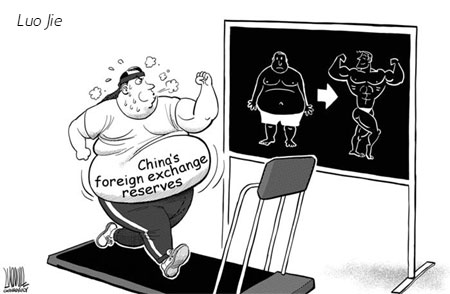
|
BIZCHINA> Review & Analysis
 |
|
Foreign exchange assets require restructuring
By Wang Daxian (China Daily)
Updated: 2009-03-23 07:43
 Against the backdrop of a financial crisis that threatens to get even worse, the government has two means to manage China's foreign exchange reserves: One is to take proactive measures to prevent foreign exchange reserves from increasing too rapidly; the other is to improve the foreign exchange reserve structure as well as the structure of financial assets and commodities in the country's international reserves.
China should gradually adjust the structure of its reserve currencies but avoid taking any drastic steps. Roughly speaking, US dollar assets account for 70 percent of China's foreign exchange reserves, euro assets for 20 percent and Japanese yen assets for 10 percent. China should make plans for gradually reducing its dollar assets while increasing its euro assets over a period of time and for China's own benefit, long enough to ensure that the US currency maintain a relatively stable value. China should also make efforts to increase its commodity assets and reduce its foreign exchange reserve assets in its international reserves. The international crude oil price has plummeted from nearly $150 a barrel at the highest to around $40 now. Gold, which once topped $1,000 an ounce, has come down to about $900 per ounce. Under such circumstances, China should buy crude and gold assets. Because of the negative correlation between the prices of gold and the US dollar, many countries, in the developed world in particular, have already moved to increase their gold reserves. By contrast, China's gold reserve, which stands at 600 tons, only occupies 1.1 percent of its international reserves, far lower than the world average of 10.2 percent. As the yuan is not fully convertible, nor is it an international settlement currency, China may consider the following two means to help resolve the huge pressure to appreciate the yuan caused by the country's huge foreign exchange reserves.
First, China should continue to encourage foreign financial institutions to issue yuan bonds. They can use the funds raised on the bond market to buy US dollars from the Chinese central bank. Apart from the benefit of lending US dollars to foreign investors, such an arrangement can also lower investment risks, especially the exchange rate risk, compared with buying US Treasury bonds. Second, Chinese commercial banks should be allowed to extend yuan loans to foreign banks, which in turn can use the borrowed money to buy US dollars from China's central bank and pay back the principal and interest later on an annual basis. Both arrangements will be conducive to the process of turning the yuan into an international currency that is fully convertible. Moreover, the Chinese government can spend the foreign exchange reserves on advanced equipment from abroad to help foster China's innovation. The government can also use the foreign exchange reserves to procure equipment overseas to improve the country's educational and medical facilities, for construction of rural infrastructure, for energy conservation, and for work safety and environmental protection. These State-owned assets can also be sold to domestic institutions and enterprises at preferable prices. By this means, the private sector, traditionally at a disadvantage in competing with State sectors, will get a shot in the arm for development. The root cause for the continuous increase in China's foreign exchange reserves points to the imbalanced structure of its economy. Therefore, China needs a fundamental change in its mode of economic growth. China should make its monetary policy more independent and further reform its exchange rate forming mechanism, making it more flexible. In addition, the two-way floating of the yuan's exchange rate will ease market expectations of yuan appreciating and discourage advance collection of foreign exchange payments by exporters, or delayed payments in foreign exchange by importers. The author is a special researcher with the Shanxi Academy of Social Sciences. The article was reprinted from Shanghai Securities News
(For more biz stories, please visit Industries)
|
|||||
主站蜘蛛池模板: 久久久青草 | 久久视奸 | 欧美13一14周岁a在线播放 | 日韩毛片免费视频一级特黄 | 亚洲精品国产啊女成拍色拍 | 亚洲视频在线观 | 国产精品久久国产精品99 | 色一欲一性一乱一区二区三区 | 国产精品手机在线观看 | 欧美一级毛片免费网站 | 国产精品久久久久久久久免费hd | 欧美精品在线一区 | 亚洲欧美在线观看播放 | 国产精品一区二区资源 | 美美女高清毛片视频黄的一免费 | 在线观看国产一区二区三区 | 亚洲高清免费视频 | 亚洲欧美日韩精品在线 | bt天堂午夜国产精品 | 日本天堂网在线 | 成人在线免费 | 在线观看精品视频 | 国产亚洲精品久久 | 精品国产呦系列在线看 | 中国老太卖淫播放毛片 | 美女张开腿给男生桶下面视频 | 一级美国片免费看 | 三级黄色片网站 | 日本a级毛片免费视频播放 日本a级三级三级三级久久 | 黄色毛片视频在线观看 | 成年人网站免费视频 | 中文国产成人精品久久96 | 日韩在线一区二区三区视频 | 国产成人综合久久精品红 | 亚洲人成免费网站 | 日韩精品一区二区三区不卡 | 全球成人网 | 精品91精品91精品国产片 | 麻豆19禁国产青草精品 | 久久国内精品视频 | 久久精品国产400部免费看 |